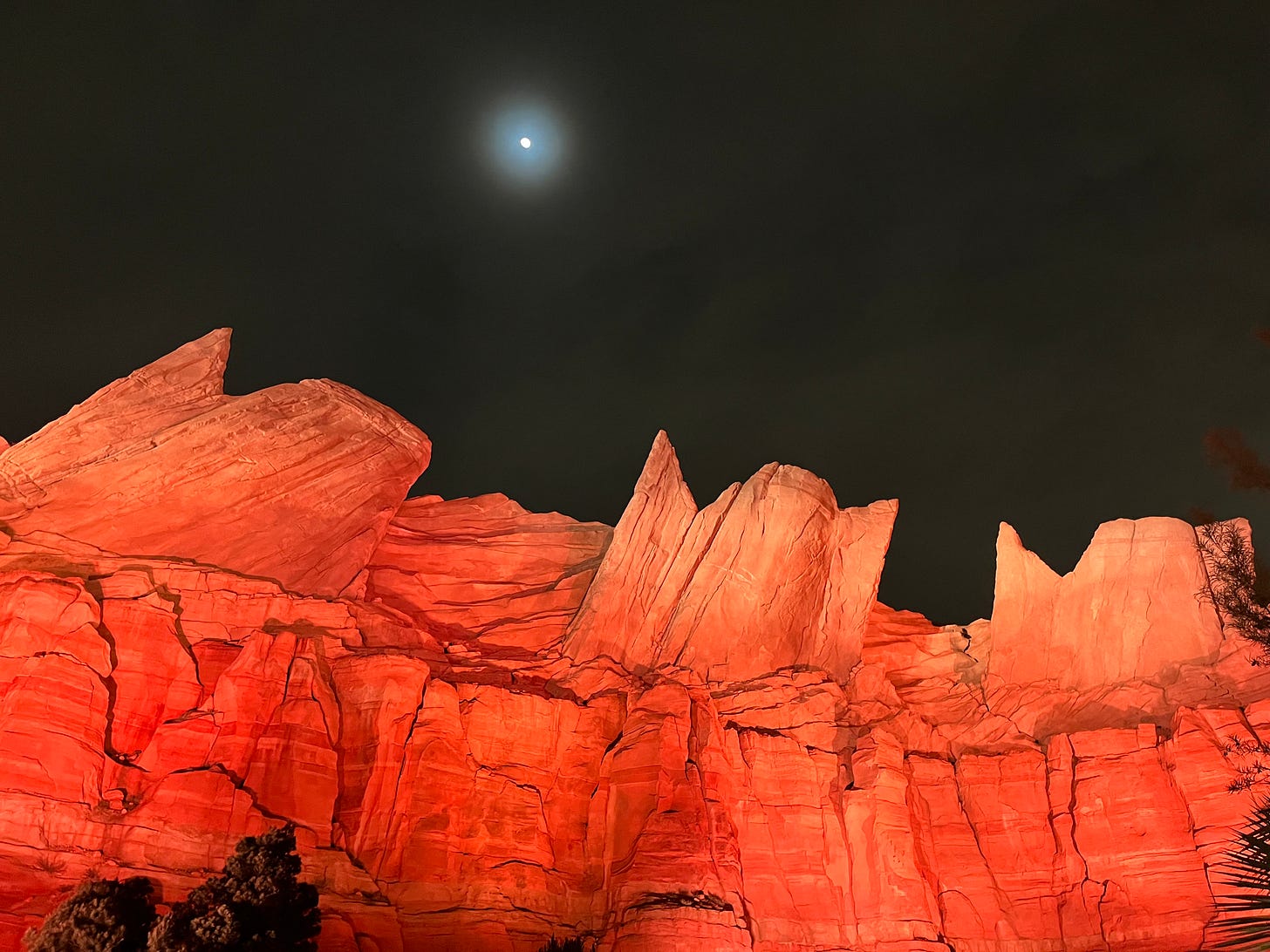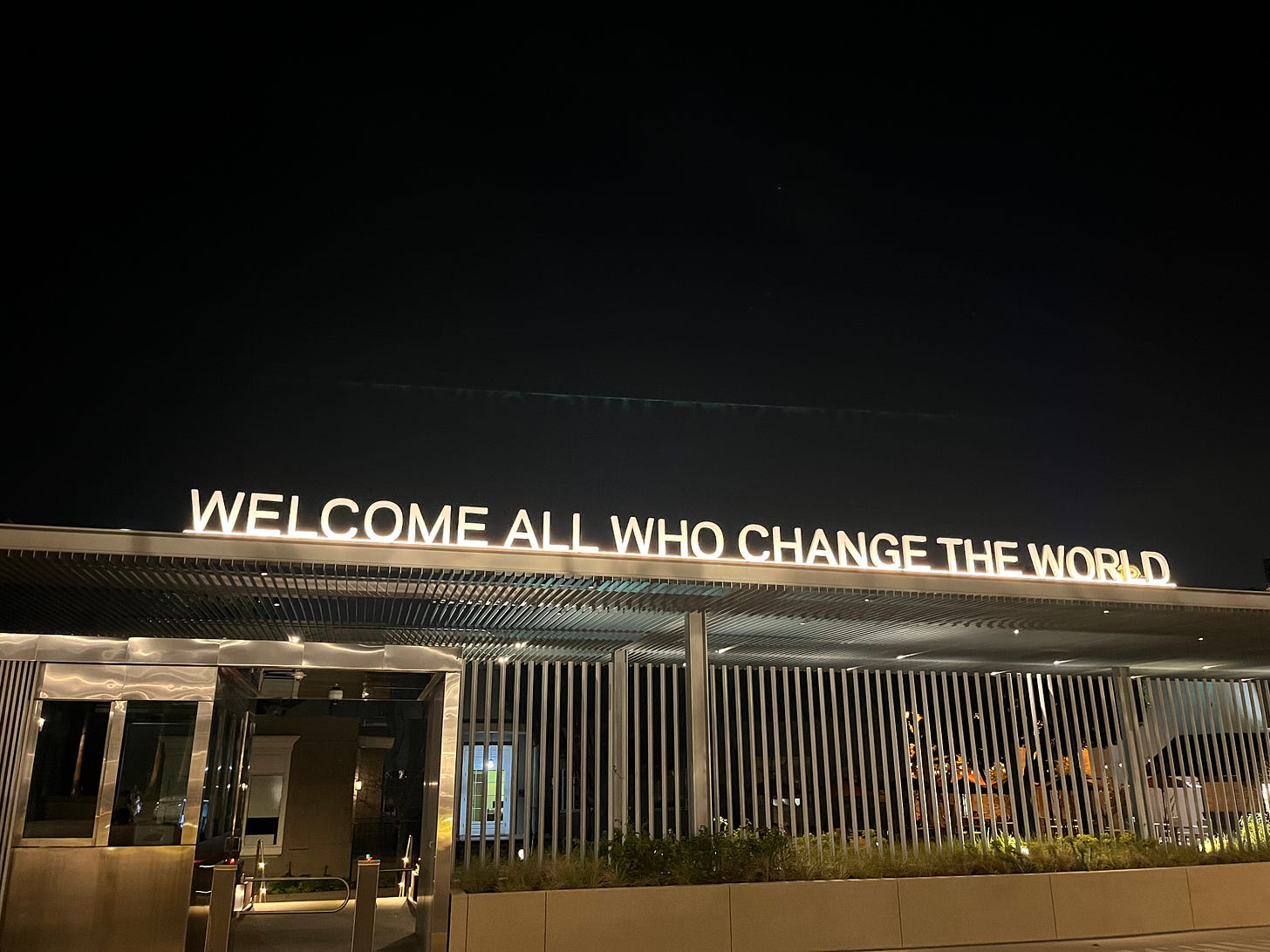Why I'm writing about climate and culture
I never expected to leave the Los Angeles Times and start a Substack. Then a story about Disneyland caught me by surprise.
“Every new beginning comes from some other beginning’s end.” — Semisonic, “Closing Time”

Beyond taking care of his family, nothing mattered more to my grandfather than leaving the world a better place. He was a rabbi who believed deeply in the Jewish concept of “tikkun olam,” repairing the world, and he practiced what he preached. He was one of the greatest influences on my life — and one of the biggest champions of my climate journalism.
So maybe it makes sense that a few hours before he passed away, I was sitting in the lobby of the hospital, doing a phone interview with Katharine Hayhoe, a renowned atmospheric scientist and climate communicator.
I was a journalist at the Los Angeles Times, and I was preparing to break the news that Disneyland — one of my very favorite places — would be converting its 70-year-old Autopia ride from outdated gasoline engines to electric vehicles.
Katharine had kindly agreed to share some expertise on the transformative power of clean energy storytelling. When you watch a TV show where the characters cook with gas-free induction stoves — or drive an EV at Disneyland — you start to see the world a little differently, she told me.
“Showing people what climate solutions look like is one of the most effective ways to get them to support action,” she said.
I had scheduled the call before I knew my beloved Saba — 100 years old and two days earlier in excellent health — would be in the hospital, barely conscious. Should I have bailed on Katharine and filed my otherwise finished story, knowing it wouldn’t be quite as good without her voice? Or perhaps rescheduled our call, and risked another reporter scooping me on the Autopia news?
A year and a half later, I still don’t know.
But I do know I’m proud of my reporting. It was actually my nagging about Autopia that prompted Disney’s promise to ditch oil-fueled cars. It’s not often as a journalist that your work makes such a direct, immediate impact.
I’m sure Saba would have told me to go ahead with the phone call if it meant telling a story that might make the world a little bit better. And I’m sure he’d be proud that the Autopia reporting led me here, to Climate-Colored Goggles, which published its first edition earlier this week.
I got started out of college covering energy for the Desert Sun newspaper in Palm Springs, then transitioned to a similar job at the Los Angeles Times. Eventually I became The Times’ first climate columnist. Through it all, I wrote email newsletters: first The Current and Climate Point for the Desert Sun/USA Today, then Boiling Point for the L.A. Times. I also hosted a podcast.
I loved being a newspaper journalist. Whether I was covering big solar farms in the desert, or gas utilities fighting electrification, or the fate of the Colorado River, I knew I was telling stories that needed to be told — and grateful to everyone who read them. I was blessed with editors who let me set my own agenda. Nobody told me what to say or how to say it.

Eventually, though, I started to feel restless. Frustrated.
Even before President Trump’s reelection, I found myself writing many of the same types of stories I was writing three years ago, five years ago, a decade ago. Solar and wind power were growing fast — but not fast enough to avert catastrophe. Climate activists couldn’t stop squabbling over which clean energy solutions were best. Even in California, politicians were often more interested in scoring political points than solving environmental problems.
And then Trump returned to power, and suddenly it became clearer than ever that U.S. climate politics were fundamentally broken: Most people wanted climate action, but it wasn’t a top priority at the ballot box. Climate wasn’t on most people’s minds, most of the time. Folks didn’t understand that we have ample solutions at our fingertips. They didn’t feel urgency.
What could I do to help?
Well, improving Disneyland was a good start. Tens of millions of people visit every year, and many of them — mostly parents with children — would soon take a ride in an electric car.
Fresh off that victory, I wrote about another cultural institution close to my heart: the Dodgers. I urged the team’s owners to dump longtime sponsor Phillips 66, a fossil fuel giant accused by California officials of a “decades-long campaign of deception” to hide the dangers of global warming. The company’s 76 gasoline ads loom large above the scoreboards at Dodger Stadium, an epic act of “sportswashing” (the sports version of greenwashing). Wouldn’t it be great if the ads came down?
No such luck. More than a year later, the Dodgers are heading to the World Series with Phillips 66 still a highly visible sponsor — despite two massive climate-fueled wildfires that ravaged L.A. County in January, and a petition signed by 28,500 people begging the team to cut ties with the oil company.
Even so, I’m undeterred. If anything, I’m invigorated.
Because what I’ve realized — what drove me to start this newsletter — is that the climate crisis is in large part a cultural problem. We have most of the technologies we need to phase out fossil fuels and slash planet-warming pollution from agriculture and other industries. But we’ll never muster sufficient political will until our cultural consciousness shifts.
That’s a job for the storytellers who shape how we see the world: the industries that bring us movies, TV, sports, social media, newspapers, food, music, advertising, video games, theme parks, art. They’re all affected by the climate crisis. They should all be telling stories that help us understand the challenges we face, and what we can do to solve them.
They’re our best chance at moving the needle, fast.
That’s why I’m writing a newsletter about climate and culture: to encourage America’s most influential storytellers to get in the game, and to help them figure out how. If we want climate progress in energy, transportation and agriculture, we need progress in pop culture, media and sports.
In other words, it’s time to start seeing the world through climate-colored goggles.
I’m not going to abandon the storylines I’ve spent 11 years covering, at least not entirely. If you care about energy policy, or the Colorado River, or public lands, I hope you’ll stick with me. These topics and others are near and dear to my heart, and my goal is to connect cultural and political change. I plan to keep writing news roundups and analyses focused on California and the American West.
Have ideas or feedback? Just reply to my emails. Tell me what you want from Climate-Colored Goggles, and I’ll do my best. Thank you for joining me on this journey.
I hope you’ll consider supporting my work with a paid subscription, if you’re able. And the more people you can tell about the newsletter, the better.
I do wish my grandfather, my Saba, were here to see me get started. He would have been sad I left the L.A. Times, but he would have loved the rad logo my brother Danny designed for this project. I probably would have had to spend a bunch of time teaching him to use Substack. It would have been awesome.
Endings are never easy. But without them, new beginnings wouldn’t be possible.
I’m ready for some new stories. Climate-Colored Goggles is where they’ll live.




I'm so sorry to hear about your grandfather, Sammy. Was he a rabbi here in LA? Which temple?
I'm surprised that the Dodgers didn't listen to you about having a fossil fuel company as a sponsor. I really expected them to cut ties with Phillips. But I know you'll keep up the pressure, and maybe they'll finally listen.
I too am surprised that climate seems to register as an issue with so few people. I'm not exactly sure why that is, given that so many of us are affected by it. I hope your newsletter is a huge success and changes that.
We have to kill the ICE industry dead. Internal combustion engines are the problem, EVs are the answer.
Americans bought nearly 16 million new cars last year, 92% of them were ICE. That's over 40,000 brand new gas-burning cars sold every single day. Given the electorate is 50/50, this means Dems are buying some 20,000 new gas cars every day.
The cheapest gas car you can buy costs about $18,000. You can buy a used Tesla Model 3 for that much money that is vastly better than some cheap econo-box gas car. What this tells us is that 100% of all new car buyers can easily afford to switch.
I like that you are attempting to enlist our talented storytellers to address this problem. Gov. Newsom has about $4 billion in yearly revenue from the Low Carbon Fuel Standard fund to spend on EV infrastructure, incentives for purchasing EVs, and other such uses. I propose that the Governor use, say, $10 million of that fund not to incentivize EVs, but to create a suite of media with the aim of dissuading people from buying ICE vehicles.
Imagine the power of tick tock videos aimed at young first-time car buyers, or 60 second TV spots geared toward GenX and Boomers who still watch TV. We have the most creative community in the world here in LA. I'm certain using their talents we can have a significant impact on the sale of new gas cars.
Our goal should be nothing less than the total end of the ICE industry globally.
China and Europe will not allow the sale of new ICE vehicles after 2035, a mere decade from now. California and ten other states will do the same. The ICE industry cannot exist without enough scale to be profitable. We can persuade people on the political left not to support Trump and MAGA with their purchase of gasoline. We don't have to persuade those on the political right because once the ICE industry is dead, they won't have the choice to buy a polluting car. That's the power we should be wielding.